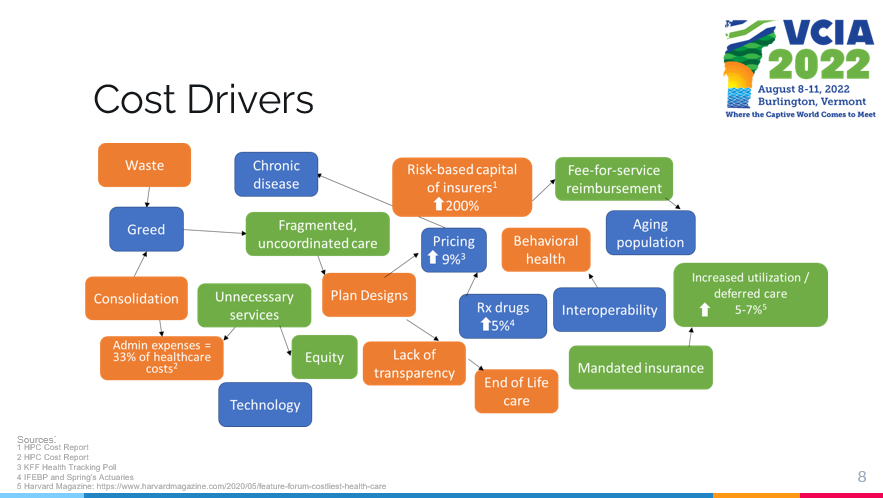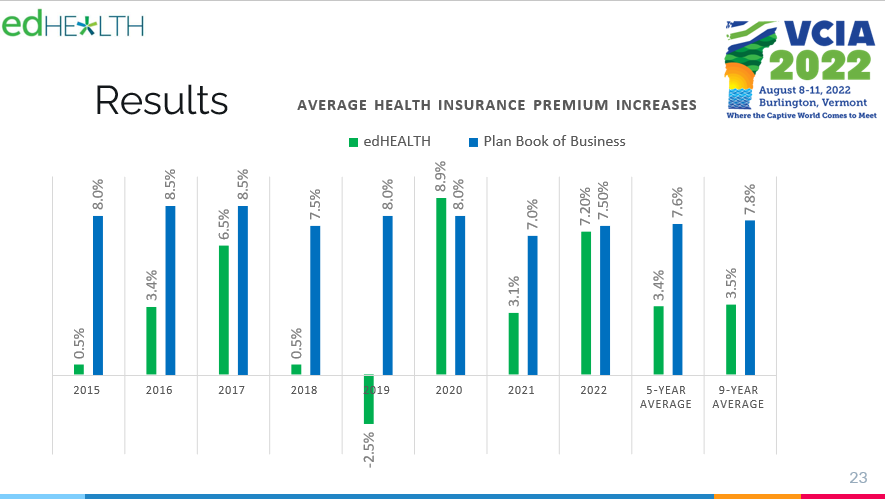With healthcare costs skyrocketing and employee needs shifting, many employers are examining how they can save money while still providing strong benefits packages. Last week I spoke at the Vermont Captive Insurance Association (VCIA)’s 2022 Annual Conference on current medical stop-loss market trends and how captives can help cut costs. My fellow panelist, Tracy Hassett, President of edHEALTH, a collection of educational institutes and client of Spring’s spotlighted their captive which has seen significant savings.
Cost of Healthcare
Healthcare costs keep climbing for both employers and employees and our actuaries predict an increase in medical trends for 2022 between 4%-7%. Looking back further, within the past decade healthcare costs have risen roughly 80% for employees and 60% for employers while economic growth has been consistent at 2.5% annually. This increase in costs is coming from a range of factors including administrative expenses, prescription drug prices, increased utilization/deferred care, and risk-based capital of insurers.

We are also seeing a transition in what employees want out of their benefits packages. Our working population is changing; boomers are retiring and transitioning from employer health insurance to Medicare. Millennials have different needs and are looking for straightforward and convenient benefits without high costs. These shifts in healthcare priorities along with high costs have slowly made self-insurance the norm, with a Spring survey reporting 64% of all employers are now self-insured.
When looking at the healthcare market the vast majority of pharmacy spending is through pharmacy benefit managers (PBMs). Employers estimate outpatient pharmacy to be about 18% of health spending, with an additional estimated 10% within medical claims. Also in 2020, overall drug spending rose by almost 5%, with utilization and new drugs driving most of this increase.

Self-Insurance
We are seeing a fundamental change in the healthcare market, and all parties within the healthcare continuum are being asked to handle risk and chase healthcare dollars. This has pushed many employers to move towards self-funding plans which allow for greater customization, more control over risk, and potential cost savings. Many of these self-insured programs are looking at putting medical stop-loss into a captive, with a Spring survey reporting that although less than 50% of self-insured programs have stop-loss coverage, 42% of those that do have it within a captive.
Within the COVID era we have also seen many changes in the industry and numerous employers are reevaluating their healthcare packages. There has been a giant spike in mental health and COVID-19 resources like telehealth, and a decline in elective surgery. These trends have left hospitals and providers with the short end of the stick, leaving self-insured employers and health plans as the parties saving the most in the insurance landscape.
Case in Point: edHEALTH
Tracy Hassett led the case study portion of the presentation, with edHEALTH being a prime example to of a captive successfully yielding savings in healthcare costs as well as flexibility of options. edHEALTH is a consortium of 25 higher education institutions who came together (originally as a group of six schools) to bend the trend in rising healthcare costs. Today, edHEALTH covers almost 15,000 employees (~30,900 lives) and aim to better understand and control their healthcare costs and risk. Tracy explained edHEALTH’s captive structure and how the captive retained savings of $6.7M since inception through 2020, in addition to paying out $3.2M in dividends.
These universities all have similar risks when it comes to healthcare, so investing in a group captive was the ideal solution. Each member chooses their own level of risk and pays for their own claims (below the established self insured retention level [SIR]), but still has control of their program. Tracy continued to explain how prescription drug costs are one of their largest challenges when trying to save money in creating/reevaluating healthcare plans. However, with their captive in the past four years edHEALTH members have saved an estimated $50M on Rx costs.

All in all, I was honored to join in the thought-provoking discussions that took place at VCIA. Since medical stop-loss is one of the biggest areas of focus for our clients right now, it was a pertinent conversation and I was glad to have the opportunity to share my perspective, as well as the success of edHEALTH. Burlington remains as perfectly quaint as ever, and I look forward to next year’s event.


